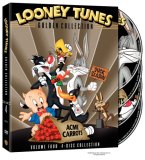| Reviews & Columns |
|
Reviews DVD TV on DVD Blu-ray 4K UHD International DVDs In Theaters Reviews by Studio Video Games Features Collector Series DVDs Easter Egg Database Interviews DVD Talk Radio Feature Articles Columns Anime Talk DVD Savant Horror DVDs The M.O.D. Squad Art House HD Talk Silent DVD
|
DVD Talk Forum |
|
|
| Resources |
|
DVD Price Search Customer Service #'s RCE Info Links |
|
Columns
|
|
|
Looney Tunes - Golden Collection, Volume Four
THE SHOW:
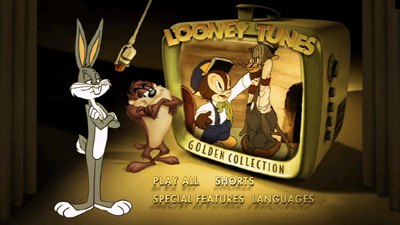
For four years now, Warner Bros. has given Looney Tunes fans an early Christmas Gift by dropping a new DVD collection in early November. Looney Tunes - Golden Collection, Volume Four has four discs with 15 cartoons on each DVD. They are arranged by theme and come replete with a cornucopia of extras.
The Looney Tunes and Merrie Melodies series are both classics of American comedy and touchstones of animation that are likely to never be topped. Designed to show in theatres before the feature-length motion pictures, they were made to appeal to children and adults alike, as both would be in the audience. Thus, they look great and are chock full of gags that play on various levels, some being lowbrow sight gags and others being more clever parody, wordplay, or visual puns. The animators often employed innuendo that would go over younger heads but hit the mark with the older crowd, and they also made jokes that were topical, satirizing popular figures or events of the time period.
When I was a kid, the only way to see these cartoons was either on Saturday morning or syndicated television, usually in truncated form. They were cut down to remove jokes that were too risqué or no longer in vogue (racial stereotypes pop up from time to time, including in the context of WWII), as well as to make room for more commercials. The television copies of these cartoons often looked like they had been dragged across the highway on their way to my local station, so I was happy when I got older to discover that there was a collector's market that kept these characters and their exploits alive. This is the market that Looney Tunes - Golden Collection, Volume Four is aimed at: animation connoisseurs who want to see the shorts in their original versions and looking as good as possible. So, much thanks to Warner Bros. for treating this essential part of their catalogue with as much respect as it deserves. These are the uncut classics, warts and all. Sometimes politically incorrect, sometimes racey, always funny.
***DISC 1: Bugs Bunny Favorites***
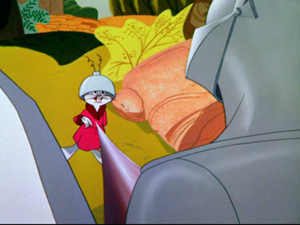
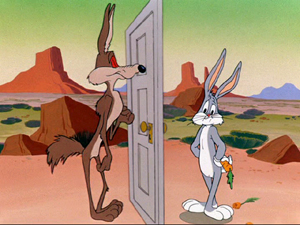
The theme in this one is obvious: a gathering of some of the more well-known Bugs Bunny shorts. While there is no overriding focus that ties these cartoons together more than its star, some of them have been chosen for how they complement each other. For instance, both "Knight-Mare Hare" and "Knighty Knight Bugs" feature the rascally rabbit in medieval settings, as does "Rabbit Hood." Or, "Southern Fried Rabbit" and "Mississippi Hare" put Bugs in a version of the American South where the Civil War hasn't quite ended.
Bugs is always fun. His appeal is that he is the impish wiseacre with no inhibitions, the guy who can pull one over on anybody and rarely gets bested. He's the fearless person we all want to be, ready with a clever retort and not taking crap from anybody. My favorite selections on this disc are the two cartoons where he feuds with Wile E. Coyote, "Operation: Rabbit" and "To Hare is Human." Out of the Road Runner context, Wile E. is a different character. Namely, he talks. When he goes up against Bugs, director Chuck Jones has this hapless villain become a pompous windbag, like an early Frasier Crane with a killing streak (Sideshow Bob, in other words). His schemes are relatively the same as in the Road Runner series, but the added fun is that he can now explain them to his victim, a James Bond-like bad guy who spends so much time flapping his gums, his booby traps end up making him the booby.
Other highlights include when Bugs meets other animals, like when he squares off with some organ grinder monkeys in "Hurdy-Gurdy Hare" or tries to deliver a lost penguin back to his home in "8 Ball Bunny."
The full list of cartoons on DVD 1:
Roman Legion-Hare
The Grey Hounded Hare
Rabbit Hood
Operation: Rabbit
Knight-mare Hare
Southern Fried Rabbit
Mississippi Hare
Hurdy-Gurdy Hare
Forward March Hare
Sahara Hare
Barbary-Coast Bunny
To Hare is Human
8 Ball Bunny
Knighty Knight Bugs
Rabbit Romeo
***DISC 2: A Dash of Tashlin***
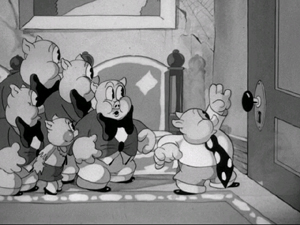
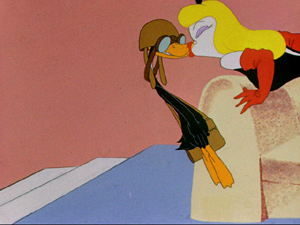
Frank Tashlin was not a name I was overly familiar with before the spotlight put on him here. He doesn't get bandied about the way your Averies and Frelengs do, but this overview of his career suggests he was a rather faithful standby at the studio. He directed a lot of early Porky Pig cartoons, as well as various one-off features with animal casts performing morality plays (the squirrels preparing for winter in "Now that Summer is Gone") or engaging in strings of gags illustrating a theme (the ice skating of "Cracked Ice" or the travel magazines come to life in "You're An Education"). Many of the films are black-and-white, and put next to the color shorts, it shows how Tashlin (sometimes credited as Frank Tash) crossed over two different eras. The older films aren't nearly as good to my mind, being less sophisticated and developmental, but it is neat to see the breadth of what one director accomplished.
There are two Daffy Duck cartoons on this DVD, and they are actually two of my old favorites, so I must chastise myself a little for not realizing Tashlin directed them. The first is "Plane Daffy," a war-era 'toon featuring a curvaceous Mata Hari that has been sabotaging the United States' carrier pigeon fleet. Daffy is called in because he is a woman hater, but even he has trouble escaping the spy's feminine spell. The second is "The Stupid Cupid," where Elmer Fudd plays a malicious cupid that takes pleasure in making Daffy fall in love with completely inappropriate women.
I noticed two regular traits of the Tashlin style in a majority of the cartoons. One is a penchant for round shapes, which he put to particular use in the Porky Pig cartoons, making the rotund pigs look like big balloons with blazing apple cheeks. The second is extreme close-ups. Often, characters turn to the camera and lean all the way in. Bad guys fill up the whole screen with their menace, or in "Cracked Ice," the W.C. Fields pig speaks directly to the movie-going audience.
The full list of cartoons on DVD 2:
The Case of the Stuttering Pig
Little Pancho Vanilla
Little Beau Porky
Now that Summer is Gone
Porky in the North Woods
You're an Education
Porky's Railroad
Plane Daff
Porky the Fireman
Cracked Ice
Puss n' Booty
I Got Plenty of Mutton
Booby Hatched
Unruly Hare
The Stupid Cupid
***DISC 3: Speedy Gonzales in a Flash***
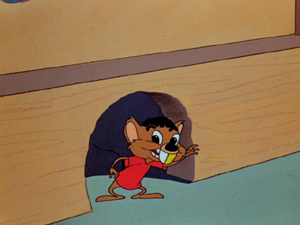
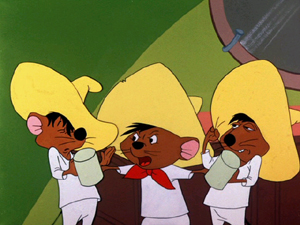
A smattering of the Speedy Gonzales shorts, beginning with the very first, "Cat-Tails for Two," which has the original version of the character, before he had a sombrero and when he had a gold tooth. Some may blanch at the portrayal of the Mexican mice as lazy partiers, but the Speedy cartoons are actually pretty funny. The fastest mouse alive takes on a variety of villains--feline duos, buzzards, a mouse Bandito, Sylvester the Cat--to save his friends from certain consumption or starvation (when no one else can get past the cat guarding the cheese factory, Speedy can). These predators are, of course, flummoxed by Speedy's abilities and can-do attitude. As filmmaker Greg Ford (he directed a lot of the late '80s Bugs Bunny material) notes in his commentary for "Mexican Boarders," these stories of the rodent community in Mexico often subvert the stereotype by showing there is more going on behind the cliché than such clichés would usually suggest. He points to Speedy's cousin, Slowpoke Rodriguez, who explains that he may be slow in the feet, but he is fast in the cabeza, shortly before outsmarting Sylvester.
One of my favorite gags is in "Tabasco Road," when Speedy rescues his friend from a loutish cat's mouth with such speed we miss the action. Realizing this, the mouse breaks the fourth wall and turns to the audience, explaining he will show it again in slow motion. We then see him hit the cat on the foot with a mallet so he opens his mouth, grabbing the other mouse off the cat's tongue, and then dropping a stick of dynamite down the cat's throat. Fantastic!
The majority of the Speedy cartoons were directed by Friz Freleng, and they maintain a consistent tone and quality for most of the run. DVD 3 drags by the end, though. The twelfth cartoon is "Nuts and Volts," the final short the classic Warner Bros. stable made before the doors were closed and cheaper alternatives were sought. Freleng formed a production company with David H. DePatie and, in addition to making the Pink Panther cartoons, picked up the manufacturing of Warner Bros. shorts. The final three selections on the Speedy Gonzales disc are from that period, and the difference in animation is quickly obvious. These were done on the cheap in order to compete in price with Saturday morning cartoon productions, and so gags are recycled from old features ("Pancho's Hideaway" has a bandito named Pancho Vanilla that is a blatant copy of Yosemite Sam and even the name is stolen from a cartoon on the Tashlin disc) and the art style is scaled way back. The stories are also strange, crossing characters over that hadn't previously met, such as when Speedy races the Road Runner in "The Wild Chase" and Sylvester and Wile E. Coyote team up to try to catch them. Even stranger is "A-Haunting We Will Go," where a witch transforms Speedy into her own doppelganger and in the guise of this old crone, Speedy tussles with Daffy Duck--who is now a father and is trying to prove to his son that there is no such thing as witches. It doesn't make much sense, and it's not very funny.
The full list of cartoons on DVD 3:
Cat-Tails for Two
Tabasco Road
Tortilla Flaps
Mexicali Shmoes
Here Today, Gone Tamale
West of the Pesos
Cannery Woe
The Pied Piper of Guadalupe
Mexican Boarders
Chili Weather
A Message to Gracias
Nuts and Volts
Pancho's Hideaway
The Wild Chase
A-Haunting We Will Go
***DISC 4: Kitty Korner***
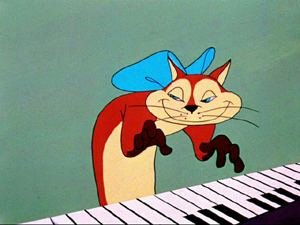
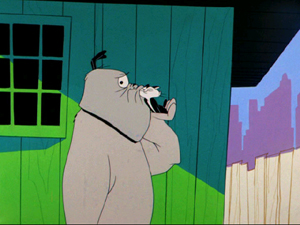
The last disc is probably my favorite. It's a varied selection of cartoons starring cats, from one-off tales about a feline who fakes being a piano prodigy (Friz Freleng's awesome "Pizzicato Pussycat") to star vehicles for Sylvester ("The Unexpected Pest," "Mouse and Garden") and Sylvester-wannabes (Porky's pet in "The Sour Puss," the pampered "Aristo-cat").
Two of the shorts feature one of my favorite duos, the bulldog Marc Antony and his kitten pal Pussyfoot. These are the Chuck Jones directed cartoons where the tiny kitten becomes the beloved pet of the big bulldog, well-known for how Marc Antony endures the cat's claws when the kitty kneads the canine's back to create a space to sleep. These are well-constructed cartoons, with fun stories and good jokes. In "Kiss Me Cat," Marc Antony has to either get Pussyfoot to catch mice or figure out how to rid the house of rodents on his own, lest his owners get rid of the kitty. In "Cat Feud," an opportunistic stray tries to use Pussyfoot to his own ends, as the younger cat wanders cluelessly through a construction site and Marc Antony keeps him out of harm's way.
By showing off like-minded cartoons rather than sticking with specific characters, DVDs 2 and 4 end up being more interesting. Fifteen cartoons in a row of any one character can get a little old, and these thematic discs hype the many faces of the Looney Tunes/Merrie Melodies catalogue. In particular on this disc, there are excellent examples of how inventive the animators could be when let loose for a one-off performance. Chuck Jones takes us for a wild, romantic ride with his cat-raised-as-a-bird story in "Go Fly a Kit," whereas Robert McKimson gets strong results in a couple of 'toons starring Dodsworth, a W.C. Fields-like cat. In "Kiddin' the Kitten" and "A Peck O' Trouble," Dodsworth cons a young cat into doing his work under the guise of training him to be a better feline. Notice how often cats are portrayed as lazy con men here? Of course, Dodsworth always has the tables turned on him, just like any other cheater in the Looney Tunes universe.
The "Kitty Korner" DVD is a perfect smattering of feline funnies, and it really caps this collection right.
The full list of cartoons on DVD 4:
The Night Watchman
Conrad the Sailor
The Sour Puss
The Aristo-Cat
Dough Ray Me-ow
Pizzicato Pussycat
Kiss Me Cat
Cat Feud
The Unexpected Pest
Go Fly a Kit
Kiddin' the Kitten
A Peck o' Trouble
Mouse and Garden
Porky's Poor Fish
Swallow the Leader
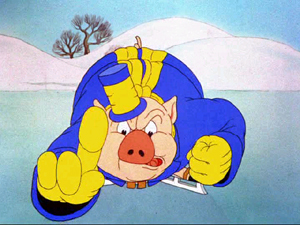
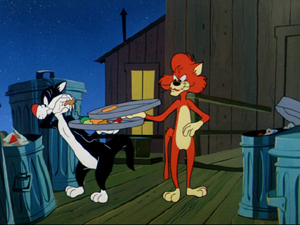
THE DVD
Video:
All the cartoons are presented in full frame. Warners has done a good job of cleaning them up, and overall, the presentation is smooth and colorful. There are occasional glitches in the individual cartoons, but most don't look like actual DVD authoring problems. They are things like a background flicker or hazy line work, and these may just be faults in the original animation. Really, I find little to complain about. I always enjoy seeing good looking versions of these cartoons after seeing beat-up syndicated prints for so long.
Sound:
The cartoons are mixed in mono, but they sound really good. There is also an alternate Spanish track.
Extras:
There are extras galore on the Gold Collection, Volume 4. They are stacked across the four discs. Each disc also has various options for how to view the cartoons. You can choose "Play All" and shotgun all 15 'toons, or you can choose cartoon by cartoon. In order to access commentaries, you do have to go to the commentary menu, however; you can't just toggle into them with your audio button when watching each short.
There are commentaries on a handful of cartoons on each disc, and the critics are chosen from a pool of people, with only a few of them going from one DVD to another. DVD 1, for instance, has six commentary tracks by director Eric Goldberg (appreciative of the work and discusses the parties involved, though seems to enjoy watching more than talking), writer Paul Dini (more intellectual, discussing theories of humor and gag construction), historian Jerry Beck (focuses on the lesser-known animators on his chosen short), and voice actress June Foray (interviewed by Beck on "Rabbit Romeo").
In addition to commentaries, the discs all have selected shorts where you can listen to music and effects tracks on their own. Though this kind of feature has been on other Looney Tunes collections, this time it ties in nicely with the other features on DVD 1 that focus on composer Raymond Scott: a six-and-a-half minute documentary on the history of his music, with interviews by voice actors, animators, and composers Mark Mothersbaugh and John Williams (whose father was in the Raymond Scott Quintet) and a short montage of sequences that used Scott's signature "Powerhouse" theme.
Disc 1 also has trailers for other Bugs Bunny DVDs, a montage for the rabbit's 50th birthday showing his full history in 3 ½ minutes, a reconstruction of interstitial sequences from an episode of TV's "The Bugs Bunny Show," the audio from a Mel Blanc recording session for a Foghorn Leghorn cartoon, and the first part of a television compilation called "Bugs Bunny Superstar." This program (which has not really been restored or remastered, the sound is particularly muted) is narrated by Orson Welles and hosted by Robert Clampett. It intercuts classic cartoons with historical information about the animation studio, illustrated with photos, live action footage, production art, and the drawings that the animators did of themselves and life at their studio, Termite Terrace. Made in 1975, it also features interviews with Tex Avery and Friz Freleng.
"Bugs Bunny Superstar" is split across two discs, and the second half shows up on DVD 2. In all, it contains nine more cartoons, though some are likely available in much better looking versions on other discs. For the interested, those cartoons are: "What's Cookin' Doc?" (1943), "The Wild Hare" (1940), "Corny Concerto" (1943), "I Taw a Putty Tat" (1949), "Rhapsody Rabbit" (1946), "Walky Talky Hawky" (1946), "My Favorite Duck" (1942), "Hair Raising Hare" (1946) and "The Old Grey Hare" (1944). Really, though, this extra is more of interest for its documentary footage than it is the 'toons.
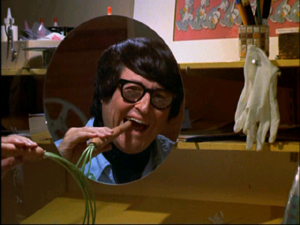
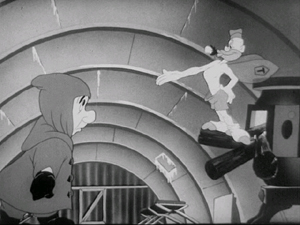
The Tashlin disc has a record ten commentaries. Jerry Beck returns from the first disc, and we also get Greg Ford, who has fun and engages in an uptempo talk, historian Daniel Goldmark (a more scholarly talker whose main area of study is music), director Eddie Fitzgerald (who worked on Tiny Toons, and like most of the commentators really enjoys chatting about the cartoons he's watching), and animator Mark Kausler (reliving a cartoon that influenced him as a child, "The Case of the Stuttering Pig"). Finally, Michael Barrier punctuates his dry commentary with 1971 audio of Frank Tashlin on three of the cartoons: "Now that Summer is Gone," "Cracked Ice," and "Pork's Poultry Plant."
A perplexing addition to the DVD is a new 2006 short directed by Daniel Haskett, "Porky and Daffy in The William Tell Overture." I'm not sure why a disc devoted to a specific director would be the place for this. At two-minutes long, it's a rapid succession of none-too-original gags that, strung together, make little narrative sense. To be brutally honest, it looks like something that was probably made for the internet.
Far more appropriate are two short programs developed from storybook ideas Tashlin had sketched out in 1951 and never completed. Read by June Foray, "Little Chic's Wonderful Mother" is about a chicken who is laughed at because he was born in an incubator, and the Stan Freberg-narrated "Tony & Clarence" is about an organ grinder and his monkey. The two shorts are put together like a storyboard reel, the camera moving over static images of art.
The balance of the second disc is taken up with three "From the Vault" cartoons starring Private Snafu, shorts that were originally made for the army during WWII. They are fun curios but the transfers are of varying quality. "The Goldbrick" is particularly grotty. (The other two are "Censored" and "The Home Front.")
DVD 3, the Speedy Gonzales disc, gives center stage to Speedy's Papa, Friz Freleng, with a newly made, hour-long documentary, Friz on Film. It's a comprehensive film following Freleng from getting in at Disney and then working on the creation of Bosko and eventually on to Warner Bros. and beyond. The director also shows up on the commentary for "Mexican Boarders." Contemporary director Greg Ford intersperses his own lively speech about the cartoon with vintage interview snippets from Friz. Other commentaries on the disc (four in all) include Jerry Beck interviewing Stan Freberg (they talk more about the general history of voice actors at Warner Bros. than they do the cartoon they are talking over) and animator Art Leonardi, as well as the return of Paul Dini. There are three shorts with music/effects-only options.
The final features on the third disc are two more "From the Vault" cartoons. Chuck Jones directed the 1956 propaganda feature "90 Day Wondering," about a guy who gets out of the army only to find civilian life has moved on without him. He feels like an outsider, and in his boredom, considers re-enlisting. Two imps then fight for his conscience. One tells him he doesn't need the army and can have a better life outside it, while the other--a soldier--shows him how much better the benefits are for serving his country. It's really strange to watch in this day and age (particularly with the problems we're having with guys not being able to get out when they are supposed to, this seems naïve), but the animation is excellent.
The second vault cartoon was made by Jones a year later. "Drafty, Isn't It?" is my worst nightmare. In the middle of the night, while an unsuspecting citizen is dreaming of doing other things with his life (being an astronaut, finding a cure for illness), another army imp sneaks in and subliminally influences him to enlist by whispering in his ear. Again, great animation with lots of stylized designs (check out that drill sergeant!), but kind of creepy seeing a humorous cartoon made for our government about government brainwashing.
DVD 4 has six commentaries, including two separate ones on "The Aristo-Cat"--one by director Eddie Fitzgerald and another with Greg Ford, who includes pieces from an old audio interview with Chuck Jones. Ford does the same for "Conrad the Sailor," wherein he discusses the influence of Sergei Eisenstein on the cartoon. Jerry Beck, June Foray, and Daniel Goldmark also come back for another round. There are three others with the music-only tracks.
Five "Behind the Tunes" featurettes were made specifically for this disc. Together, they run around fifty-three minutes, and they feature clips and interviews to discuss several topics: "The Art of the Gag," "Looney Tunes: A Cast of Thousands," "One-Hit Wonders," "Sing-a-Song of Looney Tunes," and "Wild Lines: The Art of Voice Acting." These are light but informative, and include many of the people who do commentaries, but also surprising guests like contemporary voice actors (Tom Kenney, Hank Azaria, Billy West, Mel Blanc's son Noel), Incredibles director Brad Bird, and new and old footage of some of the Looney Tunes creators.
The "From the Vault" cartoons are a little different this time. One is a hilarious Porky Pig blooper done for the Warner Bros. yearly gag reel that I haven't seen in years, and last time it was on a bootleg of banned 'toons and was an incomplete version. The other two selections are storyboard reels for the cartoons "Sahara Hare" and "Porky's Poor Fish." Animation fans will appreciate taking a glimpse at how things are put together.
The four discs are held in a foldable cardboard case with plastic double-disc trays. This then slides into an embossed slipcase.
FINAL THOUGHTS:
DVD Talk Collector Series. The Warner Bros. cartoons have an enduring appeal. Their humor is timeless and the animation is of a quality rarely seen anymore. The Golden Collection series has always treated the Looney Tunes shorts with the reverence they deserve, and the fourth volume has done nothing to tarnish that fine reputation. An excellent selection of sixty cartoons on four discs jam-packed with bonus features earns the Looney Tunes - Golden Collection, Volume Four our highest possible ranking.
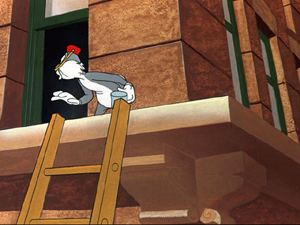
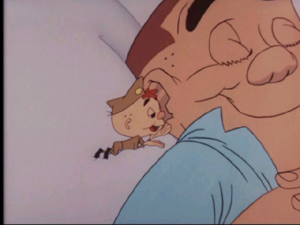
Jamie S. Rich is a novelist and comic book writer. He is best known for his collaborations with Joelle Jones, including the hardboiled crime comic book You Have Killed Me, the challenging romance 12 Reasons Why I Love Her, and the 2007 prose novel Have You Seen the Horizon Lately?, for which Jones did the cover. All three were published by Oni Press. His most recent projects include the futuristic romance A Boy and a Girl with Natalie Nourigat; Archer Coe and the Thousand Natural Shocks, a loopy crime tale drawn by Dan Christensen; and the horror miniseries Madame Frankenstein, a collaboration with Megan Levens. Follow Rich's blog at Confessions123.com.
|
| Popular Reviews |
| Sponsored Links |
|
|
| Sponsored Links |
|
|
| Release List | Reviews | Shop | Newsletter | Forum | DVD Giveaways | Blu-Ray | Advertise |
|
Copyright 2024 DVDTalk.com All Rights Reserved. Legal Info, Privacy Policy, Terms of Use,
Manage Preferences,
Your Privacy Choices | |||||||









